Lanchester Motor Company
|
Lanchester Motor Company Logo | |
| Private | |
| Industry | Automotive |
| Fate | purchased by BSA group 1930 |
| Successor | The Daimler Company Limited |
| Founded | (business) Birmingham 1899 |
| Founder |
Frederick Lanchester George Lanchester Frank Lanchester |
| Defunct | dormant since 1955 but currently listed as 'active' |
| Headquarters | (to 1930) Armourer Mills Birmingham, England |
Number of locations |
(to 1930) Works: Armourer Mills Sparkbrook Birmingham Showrooms: 88 Deansgate Manchester 95 New Bond Street London |
Key people |
(to 1930) Founders Trevor Hamilton Barnsley Whitfield brothers Pugh brothers J S Taylor |
| Products | Motor vehicles |
| Parent | (after 1930) The Daimler Company Limited |
| Owner | Tata Group through Jaguar Land Rover |
|---|---|
| Country | United Kingdom |
| Discontinued | 1955 but company still exists |
| Markets | Automotive |
| Previous owners |
Lanchester (1895–1930) BSA Group (1930–60) Jaguar Cars (1960–66) British Motor Corporation (1966) British Motor Holdings (1966–68) British Leyland (1968–84) Jaguar Cars (1984–89) Ford (1989–2007) |
The Lanchester Motor Company Limited was a car manufacturer located until early 1931 at Armourer Mills, Montgomery Street, Sparkbrook, Birmingham, and afterwards at Sandy Lane, Coventry England.
Lanchester was purchased by the BSA Group at the end of 1930, after which its cars were made by Daimler on Daimler's Coventry sites. So, with Daimler, Lanchester became part of Jaguar Cars in 1960. The rights to the Lanchester brand now belong to Tata Motors of India, though Lanchester has been dormant since the last Lanchester rolled off the line in 1955. The Lanchester Motor Company Limited is still registered as an active company and accounts are filed each year, although as of 2014 it is marked as "non-trading".
History
The three brothers
1910 example
Edwardian Lanchesters set their own conventions, they were very expensive and intended to last 'forever'
This business was begun by the three Lanchester brothers, Frederick, one of the most influential automobile engineers of the 19th and 20th centuries, George and Frank who together incorporated The Lanchester Engine Company Limited in December 1899 retaining the financial support they had previously received from the two brothers, Charles Vernon Pugh and John Pugh of Rudge-Whitworth. Others who took directorships included the Whitfield brothers, J. S. Taylor and Hamilton Barnsley – a master builder who sold the business to BSA-Daimler in 1931.[2]
Work on the first Lanchester car had been started in 1895, significantly designed from first principles as a car, not a horseless carriage, and it ran on the public roads in February or March 1896.[3] It had a single-cylinder 1306 cc engine with the piston having two connecting rods to separate crankshafts and flywheels rotating in opposite directions giving very smooth running. A two-cylinder engine was fitted to the same chassis in 1897 and a second complete car was built alongside it. This led on to the first production cars in 1900, when six were made as demonstrators.[3] These had two-cylinder, 4033 cc, horizontal air-cooled engines, retaining the twin crankshaft design. Steering was by side lever not wheel. The gearbox used epicyclic gearing. The first cars were sold to the public in 1901. In 1902 Lanchester became the first company to market disc brakes to the public. They were mechanical and on the front wheels only. The discs were very thin and made of a very soft metal like brass. Although probably leaving much to be desired, they completely fit the definition of a disc brake, and beat all others to market by many years.
Crystal Palace Automobile Show, January 1903
The Lanchester Motor-Car Company show a number of handsome vehicles. The design here is novel throughout, or, rather, it differs from other designs, as the Lanchester car was one of the first English cars to be made. The engine is horizontal and is balanced in a most ingenious manner, the change speed gear is by epicyclic trains controlled by band brakes, the electric sparking is most ingeniously contrived, and the suspension is also of special type. To describe the mechanism of these cars would, however, be impossible without elaborate diagrams. They are notable for their easy running and absence of vibration.[4]
All bodies were made by external coachbuilders until 1903 when a body department was set up and up to 1914 most cars carried Lanchester built bodies.[3] In 1904, despite a full order book, the business ran out of money and The Lanchester Engine Company Limited was put into voluntary liquidation. After a period of management by a receiver the business was re-organised re-capitalized and incorporated as The Lanchester Motor Company Limited later that year.[3]
The 1904 models had 2470 cc, four-cylinder, water-cooled, overhead-valve engines featuring pressure lubrication, very unusual at the time, and were now mounted with the epicyclic gearbox between the front seats rather than centrally resulting a design with the driver sitting well forwards and no bonnet. Six-cylinder models joined the line up in 1906. The specification started to become more conventional with wheel steering as an option from 1908, becoming standard from the end of 1911,[3] and pedals and gear lever replacing the original two-lever system of gear changing. George Lanchester was now in charge, Frederick having resigned in 1913, and the engine moved further forward to a conventional position in the sporting, side-valve, 5.5-litre six-cylinder Forty but very few were made before the outbreak of World War I. A distinctive feature of the engine's valves was their use of leaf springs, rather than coil springs.[5] Frank Lanchester ran the London sales office.
- before 1914
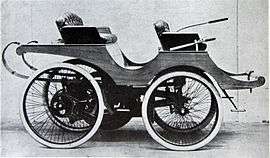 1895
1895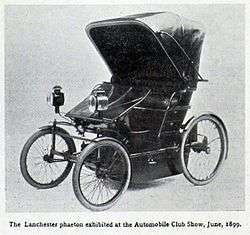 1899
1899 1901
1901 1903
1903- 1910
- 1912
 1914
1914- 1914
War
During World War I the company made artillery shells and some aircraft engines but some vehicle production continued with the Lanchester 4x2 Armoured Cars built on the Lanchester 38 hp[1] chassis for use by the Royal Naval Air Service on the Western Front.
Postwar
After the first World war the company adopted a single model policy and the Forty was re-introduced with a 6.2-litre overhead-cam engine in unit with a 3-speed gearbox still using epicyclic gears and a worm drive rear axle. It was very expensive, dearer than a Rolls-Royce Silver Ghost and to maintain production a smaller car, the Twenty One joined the range in 1924. This had a 3.1-litre, six-cylinder engine, now with removable cylinder head, mated to a four-speed conventional gearbox and four-wheel brakes. It grew to the 3.3-litre Twenty Three in 1926. The Forty was finally replaced by the Thirty with straight-eight 4.4-litre engine in 1928. A further series of armoured cars was made in 1927, using a six-wheeled version of the Forty chassis.
For 1928 there was George's last design, a 4446 cc straight-8; only 126 were made before the economic depression effectively killed demand.[6]
Olympia 1930
Twelve months after the Wall Street Crash these were the cars shown by Lanchester on their stand at the Olympia Motor Show in October 1930:[7]
- 21 hp[1] 6-cylinder landaulette by Maythorn, £1,775, chassis only £1,050
- 31 hp 8-cylinder limousine by Hooper, £2,300, chassis only £1,325
- 31 hp 8-cylinder 6/7-seater coupé de ville by Windovers £2,435
The engines were 3,330 and 4,440 cc respectively, their wheelbase and track:
- 6-cylinder: 11 ft 1in and 4 ft 8in
- 8-cylinder: 11 ft 10½ in and 4 ft 8in
- Conventional 1920s shapes before the sale to BSA Group
 23 hp
23 hp- 30 hp
Sale or liquidation
Within weeks their bank called in the company's overdraft of £38,000 forcing immediate liquidation of the company's assets. Because their current premises were next door to BSA's Armourer Mills at Sparkbrook a sale to BSA made sense. Thomas Hamilton Barnsley (1867–1930), the principal shareholder, chairman and managing director negotiated a sale of the whole share capital to BSA group shortly before his death on Christmas Day 1930. BSA's purchase of the whole of the shares was completed in January 1931 for £26,000, a fraction of the value of the assets. Car production was transferred to Lanchester's new sister subsidiary, Daimler, at Motor Mills, Sandy Lane, Radford, Coventry.[8][9]
Daimler
George Lanchester was kept on as a senior designer and Frank became the Lanchester sales director. The first new offering, still designed by George Lanchester, was a version of the Daimler Light Twenty, the Lanchester Eighteen with hydraulic brakes and a Daimler fluid flywheel. The Ten of 1933 was an upmarket version of the BSA Ten. The pre-war Fourteen Roadrider of 1937, was almost identical to the Daimler New Fifteen.
The then Duke of York, a repeat customer during the 1920s and 1930s, preferred this less showy version of a Daimler car and took delivery of a pair of specially built Daimler straight-eight limousines with the Lanchester grille and badges.
Post war, a ten-horsepower car was reintroduced with the 1287 cc LD10 which didn't have a Daimler equivalent and the four-cylinder 1950 Fourteen / Leda. The very last model, of which only prototypes were produced, was called the Sprite.
- Badge engineering
 Ten made 1933-1936
Ten made 1933-1936- Ten sports saloon
body by Barker 1951 example 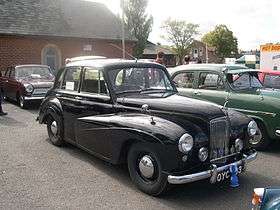 Leda or Fourteen
Leda or Fourteen
1953 example
Jaguar, Ford, Tata
Daimler was in decline, and in 1960 BSA sold Daimler's premises and business to Jaguar Cars who have since used the Daimler name on their most expensive products. Jaguar has moved into and out of the Ford group and since 2008 Jaguar, Lanchester belongs to Tata Motors.
Monument
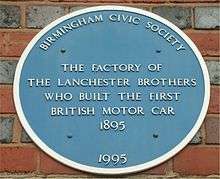
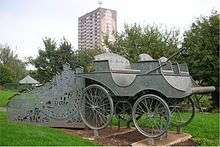
An open-air sculpture, the Lanchester Car Monument, in the Bloomsbury Heartlands area of Birmingham, designed by Tim Tolkien, on the site where Lanchester built their first four-wheel petrol car in 1895.
Lanchester cars
| Type | Engine | Approx Production | Year | Notes |
|---|---|---|---|---|
| Lanchester Five[1] | 1306 cc single-cylinder air-cooled | 1 | 1895 | Experimental |
| Lanchester Eight | 3459 cc twin-cylinder air-cooled | 3 | 1897–1898 | Experimental |
| Lanchester Ten | 4033 cc twin-cylinder air-cooled | 1900–1904 | First production model | |
| Lanchester Twelve | 4033 cc twin-cylinder water-cooled | 1903–1904 | ||
| Lanchester Sixteen | 4838 cc twin-cylinder air-cooled | 20 [3] | 1903–1904 | |
| Lanchester Eighteen | 4838 cc twin-cylinder water-cooled | 6 [3] | 1904 | |
| Lanchester Twenty | 2472 cc overhead-valve four-cylinder water-cooled | 1904–1911 | ||
| Lanchester Twelve | 3974 cc twin-cylinder overhead-valve water-cooled | 1906–1908 | ||
| Lanchester 28 | 3654 cc six-cylinder overhead-valve water-cooled | 1906–1911 | ||
| Lanchester 50 | 8145 cc six-cylinder overhead-valve water-cooled | 1 car, 2 engines | 1907 | Experimental |
| Lanchester 38 | 4856 cc six-cylinder overhead-valve water-cooled | 1911–1914 | ||
| Lanchester 25 | 3137 cc four-cylinder overhead-valve water-cooled | 1912–1914 | ||
| Lanchester 40 | 5482 cc six-cylinder side-valve water-cooled | 1914 | ||
| Lanchester 40 | 6178 cc six-cylinder overhead-cam water-cooled | 392[10] | 1919–1928 | Chassis £2200. Four-wheel brakes from 1924 |
| Lanchester 21 | 2930 cc six-cylinder overhead-cam water-cooled | 735 (including Twenty Three)[10] | 1923–1926 | Chassis £1000. |
| Lanchester 23 | 2930 cc six-cylinder overhead-cam water-cooled | 735 (including Twenty One)[10] | 1926–1931 | Vacuum servo. |
| Lanchester petrol-electric | 1927 | Experimental; now in Thinktank, Birmingham Science Museum | ||
| Lanchester 30 hp | 4400 cc eight-cylinder overhead-cam water-cooled | 126[10] | 1929–1932 | Chassis £1325 |
| January 1931 business purchased by The Birmingham Small Arms Company Limited | ||||
| Lanchester 15/18 and Eighteen | 2504 cc (2390 cc from 1935, 2565 cc from 1936) six-cylinder overhead-valve water-cooled | 2650 approx[11] | 1932–1940 | Badge engineered Daimler Light 20. Fluid flywheel. |
| Lanchester Ten LA10 | 1203 cc (1444 cc from 1936) four-cylinder overhead-valve water-cooled | 12250 approx[11] | 1933–1936 | Fluid flywheel. Hydraulic brakes until 1935. |
| Lanchester Light Six | 1378 cc six-cylinder overhead-valve water-cooled | 1075 approx[11] | 1935–1936 | Saloon, Sports Saloon, Drophead Coupe. Similar to BSA. |
| Lanchester Eleven | 1444 cc four-cylinder overhead-valve water-cooled | 2000 approx[11] | 1937–1940 | Saloon, Sports Saloon. |
| Lanchester Fourteen Roadrider | 1527 cc (1809 cc from 1938) six-cylinder overhead-valve water-cooled | 2000 approx[11] | 1937–1940 | Saloon, Sports saloon. bendix brakes |
| Lanchester Ten LD10 | 1287 cc four-cylinder overhead-valve water-cooled | 3030 | 1946–1951 | Independent front suspension, Mechanical brakes |
| Lanchester Fourteen/Leda | 1968 cc four-cylinder overhead-valve water-cooled | 2100 | 1950–1954 | Appropriated for badge engineered 1953 Daimler Conquest. Saloon and drophead coupe. |
| Lanchester Sprite | 1622 cc four-cylinder overhead-valve water-cooled | 10 | 1954–1956 | Hobbs automatic gearbox. Did not reach production. |
See also
References
- 1 2 3 4 RAC Rating
- ↑ Anthony Bird & Francis Hutton-Stott, Lanchester Motorcars, A History, Cassell, London 1965
- 1 2 3 4 5 6 7 Georgano, N. (2000). Beaulieu Encyclopedia of the Automobile. London: HMSO. ISBN 1-57958-293-1.
- ↑ The Crystal Palace Automobile Show, The Times, Saturday, Jan 31, 1903; pg. 9; Issue 36992; col A
- ↑ Rankin Kennedy C.E. (1912). The Book of the Motor Car. Caxton.
- ↑ Apral, K. "Lanchester 1930". www.classiccarcatalogue.com. Retrieved 10 July 2013.
- ↑ The Olympia Show.-Bigger Cars, British And Foreign The Times, Thursday, Oct 23, 1930; pg. 8; Issue 45651
- ↑ "The Lanchester Company". From our motoring correspondent. The Times, Tuesday, 6 January 1931, p. 10; Issue 45713
- ↑ "The Birmingham Small Arms Company. A difficult trading year, important transactions effected". The Times, Saturday, 28 November 1931, p. 17; Issue 45992
- 1 2 3 4 Baldwin, N. (1994). A-Z of Cars of the 1920s. Devon, UK: Bay View Books. ISBN 1-870979-53-2.
- 1 2 3 4 5 Sedgwick, M. (1989). A-Z of Cars of the 1930s. Devon, UK: Bay View Books. ISBN 1-870979-38-9.
External links
| Wikimedia Commons has media related to Lanchester vehicles. |
- Lanchester 28 landau 1910
- Lanchester Register
- a Lanchester collection
- Lanchester 40 6178cc phaeton 1925
- Lanchester Roadrider 1937
- Daimler – the first Lanchester car
- Daimler – fluid flywheel
- Birmingham's Industrial History Website
| British Leyland – car companies and marques | |||||||||||||||||||||||||||||||||||||||||||||||||||||||||||||
|---|---|---|---|---|---|---|---|---|---|---|---|---|---|---|---|---|---|---|---|---|---|---|---|---|---|---|---|---|---|---|---|---|---|---|---|---|---|---|---|---|---|---|---|---|---|---|---|---|---|---|---|---|---|---|---|---|---|---|---|---|---|
| Marque | 1900s | 1910s | 1920s | 1930s | 1940s | 1950s | 1960s | 1970s | 1980s | 1990s | 2000s | 2010s | |||||||||||||||||||||||||||||||||||||||||||||||||
| Jaguar | SS Cars | Jaguar | Jaguar & Daimler |
BMH | BLMC / British Leyland | Jaguar & Daimler |
Ford (PAG) | Tata | |||||||||||||||||||||||||||||||||||||||||||||||||||||
| Daimler | Daimler | BSA | BSA | ||||||||||||||||||||||||||||||||||||||||||||||||||||||||||
| Lanchester | Lanchester | ||||||||||||||||||||||||||||||||||||||||||||||||||||||||||||
| Rover | Rover Company | Rover Company | Rover Company | Austin Rover Group & Land Rover Group (BL plc) |
Rover Group (BAe) | Rover Group (BMW) |
MG Rover Group (PVH) | ||||||||||||||||||||||||||||||||||||||||||||||||||||||
| Land Rover | Ford (PAG) | ||||||||||||||||||||||||||||||||||||||||||||||||||||||||||||
| Alvis | Alvis | BAE Systems | |||||||||||||||||||||||||||||||||||||||||||||||||||||||||||
| Standard | Standard | Standard Triumph | Leyland Motors | British Motor Heritage | |||||||||||||||||||||||||||||||||||||||||||||||||||||||||
| Triumph | Dawson | Triumph | BMW | ||||||||||||||||||||||||||||||||||||||||||||||||||||||||||
| Riley | Riley | Nuffield Organisation | BMC | BMH | |||||||||||||||||||||||||||||||||||||||||||||||||||||||||
| MG | Morris Garages (MG) | Rover Group (BMW) |
MG Rover Group (PVH) | SAIC & NAC |
SAIC | ||||||||||||||||||||||||||||||||||||||||||||||||||||||||
| Morris | Morris | Morris | |||||||||||||||||||||||||||||||||||||||||||||||||||||||||||
| Wolseley | Wolseley | ||||||||||||||||||||||||||||||||||||||||||||||||||||||||||||
| Austin | Austin | Austin | |||||||||||||||||||||||||||||||||||||||||||||||||||||||||||
| Vanden Plas | Vanden Plas | ||||||||||||||||||||||||||||||||||||||||||||||||||||||||||||
| Mini | BMW | ||||||||||||||||||||||||||||||||||||||||||||||||||||||||||||
| Princess | BMC | BLMC / British Leyland | |||||||||||||||||||||||||||||||||||||||||||||||||||||||||||
| Austin-Healey | Austin (BMC) & Donald Healey | ||||||||||||||||||||||||||||||||||||||||||||||||||||||||||||
| Marque | 1900s | 1910s | 1920s | 1930s | 1940s | 1950s | 1960s | 1970s | 1980s | 1990s | 2000s | 2010s | |||||||||||||||||||||||||||||||||||||||||||||||||
